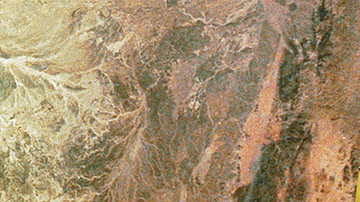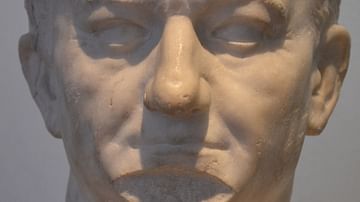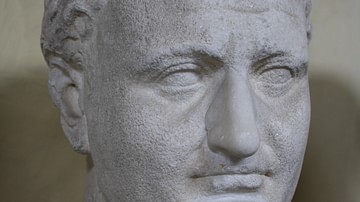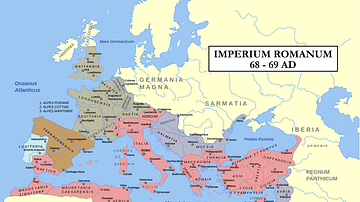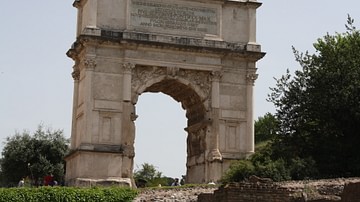The Roman Empire in the early 1st century CE was often regarded as the perfect empire. The outstanding military prowess of the Romans was used to expand the empire, and once the territories were acceptably pacified, Roman political power was installed from the capital of the empire to the local governments of the territories.
Perfectly balanced between a mixture of hard (military occupation and intervention to upkeep Roman law and instil Roman religion) and soft power (entertainment, technology, and trade), Roman rule was generally accepted and enjoyed almost everywhere the empire landed. Some subjects of Roman rule were happy to trade their religious freedom in favour of the cult of Caesar for the benefits of sanitation, for example.
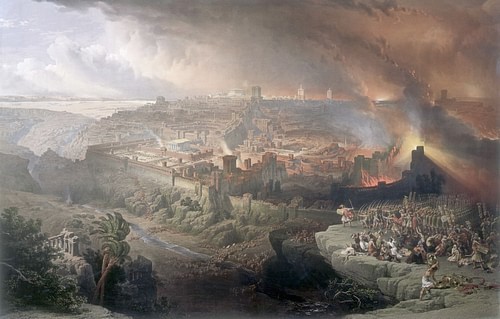
Roman Rule in Palestine
Palestine had long been Hellenised. Since 312 BCE, under Seleucos I Nicator, Greek culture flourised. However, after the Hasmonean dynasty, this Hellenisation became more than that of Greek culture and the cosmopolitan way of llife. With the Romanization of the Jewish Hellenised classes came a recrudescence of corruption that had previously flared under Antiochus IV Epiphanes and the Seleucid rule. The local Greeks and Hellenised Jewish elite supported the Romans and as such enjoyed the finer things that the Romans could deliver.The Jewish elite became more aware of their higher place in society and did whatever they could to keep the status quo. The Sadducees, the elite of which the Romans favoured, had the majority of the Sanhedrin (the ruling house) and defended Herod, the client king of Rome.
Not all Jewish people supported the Herodian stance, however. The Pharisees (who arguably merged into the Zealots) were deeply opposed to it and were incensed by the inroads that Hellenism continued to make into the Jewish religion. The Romans had unintentionally nurtured a class divide in the Jewish religion that was created under the reign of the Seleucids.
The ingrained corruption of the senate-appointed Roman procurator was transferred into the local Jewish and non-Jewish authorities. They ignored the plight of the Jews. Most of the profits of the goods that were sold in the markets of Jerusalem did not go into the Judean economy, rather they went straight to the elite, thus enraging the common Jewish man.
According to Josephus, a contemporary Roman Jewish historian who fought alongside the Jewish people in the revolt, the sheer ineptitude of the Roman governors of the province was the main cause of Jewish anger. The indifference and malice from the Judean governors reflected the malice of the emperors in Rome. When Pontius Pilate was elected by the senate to take the reins of the procurator of Jerusalem in 27 CE, the relations of the common Jewish man and the Roman people were in tatters. Pilate shared the same disdain for the Jewish people as Emperor Tiberius and quickly began to bring about a new kind of cult to replace the Jewish religion in the area.
In 64 CE, Gessius Florus presided over Judaea. He had the same indifference to the Jewish populace as Pilate but did not have the political intellect to calm the tense Jewish society when things turned sour. In other words, as Josephus states, Florus was incompetent.
Rebellion
The artificial class divide, the corruption of both the local and senate governments in the area, and the unbridled disdain for the Jewish people brought about a riot in Caesarea in 66 CE. There, the Zealots, a band of un-Hellenised anti-elite Jews, wiped out the Roman-backed elite Greeks that had inhabited the area.
Gessius Florus, in a rage of scorned hubris, plundered the Holy Temple to fund the cult of Caesar and erected statues of Emperor Nero and himself with the money he took. This obviously enraged the Jewish people. The temple was not only the centre of religious and social life for the Jewish people, but it was a sign of God's presence in the Holy City. When Florus raided the temple and ordered the residents nearby to follow his form of polytheism around it, it was the biggest insult to the Jewish religion. The Jewish people rebelled. Random attacks on Roman citizens followed throughout Judaea, particularly in the northern towns. There, in areas such as Narbata, the Jewish people overthrew the Roman government.
In response to this Jewish victory, the Roman legion in Syria, backed by the neighbouring Scythica, attempted to quell the Jewish rebellion. The Syrian Romans took large areas of the north of Judaea and Gallilee that had revolted without much effort. The Romans spread themselves too thin, however, and were ambushed and defeated on the coast of Judaea at the battle of Ben-Horon. This was a huge victory for the rebels. The Syrian Romans abandoned their posts and fled back to Syria.
Emperor Nero, angry at the impudence of the Jewish rebels, sent the Roman military general Vespasian to destroy the rebel armies and punish the citizens in the Judean province.
Vespasian and his son Titus returned stronger to Judaea with more men and slaughtered nearly every Jewish rioter in Caesarea and northern Galilee. Around 10,000 Jewish people were either killed or sold into slavery.
Romans at the gate
The remaining Jewish rioters fled Caesarea to Jerusalem; there the Jewish people stopped paying taxes in the Temple and indiscriminately murdered Roman soldiers that were stationed there.
The Zealots and Sicarii overran the Roman military garrison from Jerusalem. This was a heartening victory for the Jewish people as support for the Zealots in the city grew. This sense of Jewish dominance over the Romans was short lived.
By the year 67 CE, the Romans under Vespasian and Titus had taken back all of Judea and killed the Jewish rebels that were left. The Jewish strongholds of Jodapatha, after a 47 day siege, was now under Roman control. The Romans were on the march to Jerusalem.
The perspective of the Jewish leaders in Jerusalem, mainly Sadducee Jerusalemites, had shifted dramatically from elation to panic. They knew that the revolt would not be a success for long, and they implored the Zealots to surrender peacefully in order to save as many Jewish lives as possible. The Zealots refused.
They anticipated the insurrection that would have doubtless come if the more moderate Jewish leaders were listened to by the common person. As a result, the Zealots and the fanatical Sicarii publicly executed them and hung their dead bodies so that everyone could see the repercussions of preaching insurgent messages of peace. The moderate leaders in Jerusalem at the start of the revolution in 66 CE had all been killed by 68 CE, and not one by the hands of the Roman aggressors.
Shortly before the siege of Jerusalem, a civil war broke out in Rome. Vespasian became the new emperor in 69 CE, and Titus, the second in command in the war, took up the reins. The Romans were at the gates of Jerusalem, in 70 CE, besieging the walls.
Once the panic had hit, there was no reversing it. Try as the Zealots might, they knew that the constant stream of different opinions held by different factions of Jewish people was a hindrance to the Zealot leadership inside the city. They wanted an all-out war instead of the war of attrition that some had planned for. The Zealots, led by John of Giscala, decided to further engage the population to participate in the revolution by burning the crops and dried foods that the Sadducees and the Pharisees had stored in expectation of the Roman siege.
This worked to some extent. According to Josephus, nearly one million Jewish people from both sexes, including children, signed up to defend the city after the burning of the food. It also had disastrous consequences. The city dwellers and the soldiers starved. Those who did not suffered due to malnutrition.
As the days went by, the Roman army accepted that the only way to reconquer the city was to set up a camp just outside the walls. It was a method of range fighting. Anyone that tried to escape the city was crucified and placed either on a cross or on a wall facing the city. Terrified, the Jewish population inside the walls knew that they had to fight or run a high risk of dying in the most disrespectful way imaginable.
Attack on Jerusalem
Finally, after a seven month range battle, the Romans had damaged the city walls enough to be able to breach them. In the summer of 70 CE, the Roman soldiers penetrated the city. The obvious military superiority was on show as the Romans forced the Zealots in to fighting on the streets. The Romans were destroying and burning the city and slaughtering the Jewish people in their wake.
The Zealots and the Sicarii retreated to the Temple. The Roman legion, after several attempts at breaching the walls, set fire to the Holy Temple. The site that once gave thousands of Jewish people hope was destroyed. God, it seemed, was no longer in the city. This was the most devastating Roman blow to Judaea. The rest of the city was plundered and burned to the ground soon after the Temple fell. The Romans crushed the remaining, beleaguered Jewish resistance. Jerusalem was under complete control of the Romans by September 70 CE.
OUTCOME OF THE GREAT REVOLT
In all, Josephus claims, over one million Jewish people were killed. Jewish people were sold in to slavery and many were taken back to Rome. 70, 000 Jewish slaves built the Roman Colliseum. In Judaea, The Temple was destroyed and never rebuilt which instigated a new form of Judaism; Rabbinic Judaism. Rabbis were now the focal point of the religion, taking over from the High Priest. The synagogue became the centre of Jewish life, and with the diaspora, the Torah became the most invaluable source of knowledge for the Jewish people.
